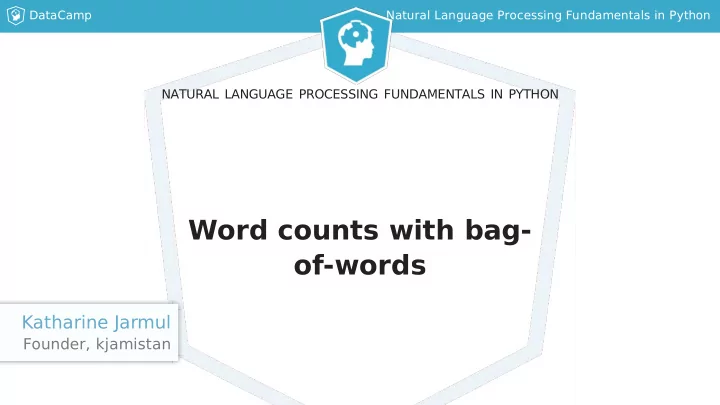

DataCamp Natural Language Processing Fundamentals in Python NATURAL LANGUAGE PROCESSING FUNDAMENTALS IN PYTHON Word counts with bag- of-words Katharine Jarmul Founder, kjamistan
DataCamp Natural Language Processing Fundamentals in Python Bag-of-words Basic method for finding topics in a text Need to first create tokens using tokenization ... and then count up all the tokens The more frequent a word, the more important it might be Can be a great way to determine the significant words in a text
DataCamp Natural Language Processing Fundamentals in Python Bag-of-words example T ext: "The cat is in the box. The cat likes the box. The box is over the cat." Bag of words (stripped punctuation): "The": 3, "box": 3 "cat": 3, "the": 3 "is": 2 "in": 1, "likes": 1, "over": 1
DataCamp Natural Language Processing Fundamentals in Python Bag-of-words in Python In [1]: from nltk.tokenize import word_tokenize In [2]: from collections import Counter In [3]: Counter(word_tokenize( """The cat is in the box. The cat likes the box. The box is over the cat.""")) Out[3]: Counter({'.': 3, 'The': 3, 'box': 3, 'cat': 3, 'in': 1, ... 'the': 3}) In [4]: counter.most_common(2) Out[4]: [('The', 3), ('box', 3)]
DataCamp Natural Language Processing Fundamentals in Python NATURAL LANGUAGE PROCESSING FUNDAMENTALS IN PYTHON Let's practice!
DataCamp Natural Language Processing Fundamentals in Python NATURAL LANGUAGE PROCESSING FUNDAMENTALS IN PYTHON Simple text preprocessing Katharine Jarmul Founder, kjamistan
DataCamp Natural Language Processing Fundamentals in Python Why preprocess? Helps make for better input data When performing machine learning or other statistical methods Examples: T okenization to create a bag of words Lowercasing words Lemmatization/Stemming Shorten words to their root stems Removing stop words, punctuation, or unwanted tokens Good to experiment with different approaches
DataCamp Natural Language Processing Fundamentals in Python Preprocessing example Input text: Cats, dogs and birds are common pets. So are fish. Output tokens: cat, dog, bird, common, pet, fish
DataCamp Natural Language Processing Fundamentals in Python T ext preprocessing with Python In [1]: from ntlk.corpus import stopwords In [2]: text = """The cat is in the box. The cat likes the box. The box is over the cat.""" In [3]: tokens = [w for w in word_tokenize(text.lower()) if w.isalpha()] In [4]: no_stops = [t for t in tokens if t not in stopwords.words('english')] In [5]: Counter(no_stops).most_common(2) Out[5]: [('cat', 3), ('box', 3)]
DataCamp Natural Language Processing Fundamentals in Python NATURAL LANGUAGE PROCESSING FUNDAMENTALS IN PYTHON Let's practice!
DataCamp Natural Language Processing Fundamentals in Python NATURAL LANGUAGE PROCESSING FUNDAMENTALS IN PYTHON Introduction to gensim Katharine Jarmul Founder, kjamistan
DataCamp Natural Language Processing Fundamentals in Python What is gensim ? Popular open-source NLP library Uses top academic models to perform complex tasks Building document or word vectors Performing topic identification and document comparison
DataCamp Natural Language Processing Fundamentals in Python What is a word vector?
DataCamp Natural Language Processing Fundamentals in Python Gensim Example (Source: http://tlfvincent.github.io/2015/10/23/presidential-speech- topics )
DataCamp Natural Language Processing Fundamentals in Python Creating a gensim dictionary In [1]: from gensim.corpora.dictionary import Dictionary In [2]: from nltk.tokenize import word_tokenize In [3]: my_documents = ['The movie was about a spaceship and aliens.', ...: 'I really liked the movie!', ...: 'Awesome action scenes, but boring characters.', ...: 'The movie was awful! I hate alien films.', ...: 'Space is cool! I liked the movie.', ...: 'More space films, please!',] In [4]: tokenized_docs = [word_tokenize(doc.lower()) ...: for doc in my_documents] In [5]: dictionary = Dictionary(tokenized_docs) In [6]: dictionary.token2id Out[6]: {'!': 11, ',': 17, '.': 7, 'a': 2, 'about': 4, ... }
DataCamp Natural Language Processing Fundamentals in Python Creating a gensim corpus In [7]: corpus = [dictionary.doc2bow(doc) for doc in tokenized_docs] In [8]: corpus Out[8]: [[(0, 1), (1, 1), (2, 1), (3, 1), (4, 1), (5, 1), (6, 1), (7, 1), (8, 1)], [(0, 1), (1, 1), (9, 1), (10, 1), (11, 1), (12, 1)], ... ] gensim models can be easily saved, updated, and reused Our dictionary can also be updated This more advanced and feature rich bag-of-words can be used in future exercises
DataCamp Natural Language Processing Fundamentals in Python NATURAL LANGUAGE PROCESSING FUNDAMENTALS IN PYTHON Let's practice!
DataCamp Natural Language Processing Fundamentals in Python NATURAL LANGUAGE PROCESSING FUNDAMENTALS IN PYTHON Tf-idf with gensim Katharine Jarmul Founder, kjamistan
DataCamp Natural Language Processing Fundamentals in Python What is tf-idf? T erm frequency - inverse document frequency Allows you to determine the most important words in each document Each corpus may have shared words beyond just stopwords These words should be down-weighted in importance Example from astronomy: "Sky" Ensures most common words don't show up as key words Keeps document specific frequent words weighted high
DataCamp Natural Language Processing Fundamentals in Python Tf-idf formula N = tf ∗ log( ) w i , j i , j df i = tf-idf weight for token i in document j w i , j tf = number of occurences of token i in document j i , df = number of documents that contain token i i N = total number of documents
DataCamp Natural Language Processing Fundamentals in Python Tf-idf with gensim In [10]: from gensim.models.tfidfmodel import TfidfModel In [11]: tfidf = TfidfModel(corpus) In [12]: tfidf[corpus[1]] Out[12]: [(0, 0.1746298276735174), (1, 0.1746298276735174), (9, 0.29853166221463673), (10, 0.7716931521027908), ... ]
DataCamp Natural Language Processing Fundamentals in Python NATURAL LANGUAGE PROCESSING FUNDAMENTALS IN PYTHON Let's practice!
Recommend
More recommend